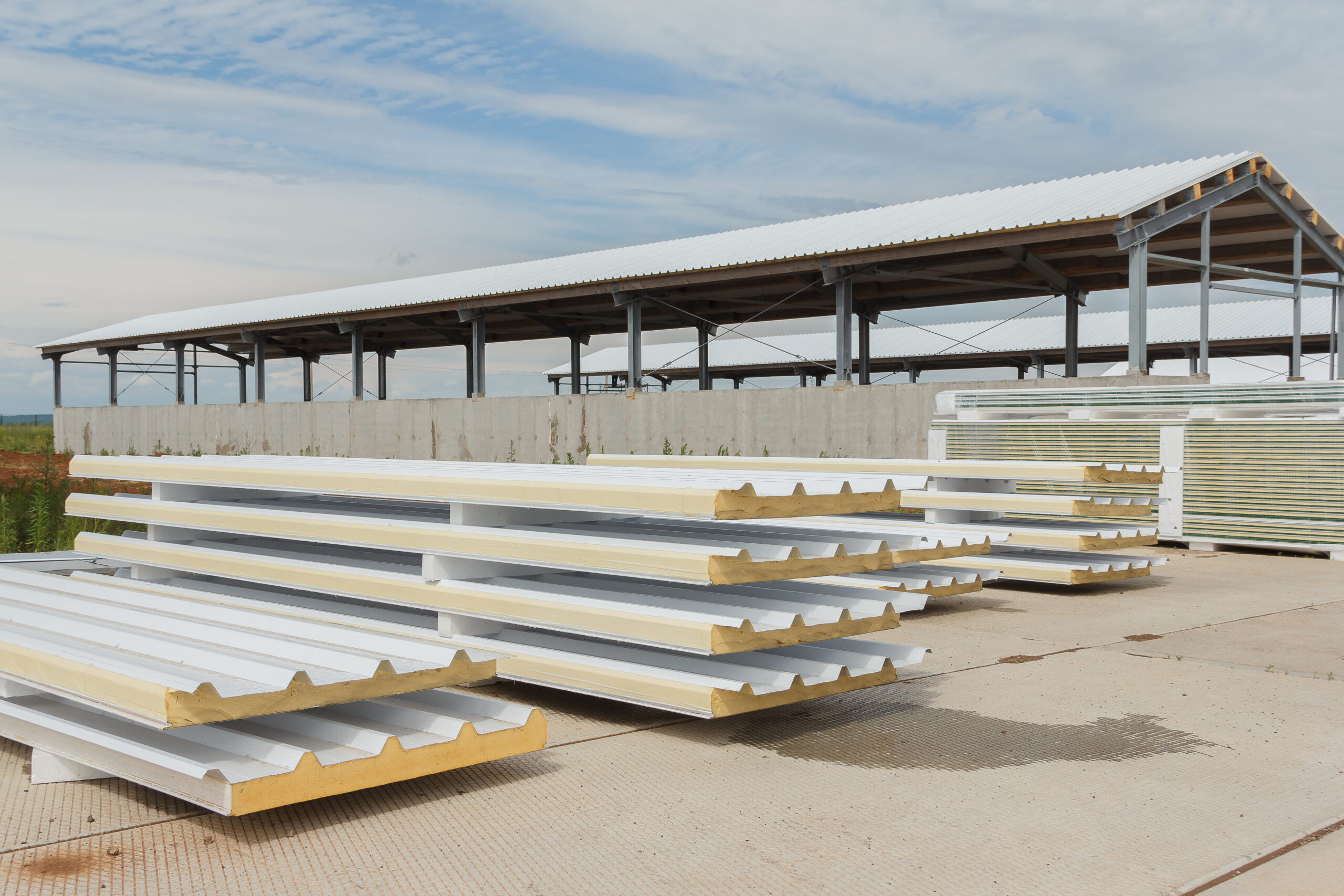Introduction
When you’re investing in a new Industrial or Agricultural building, your choice of roofing system is one of the most important decisions you’ll make.
At ReviveLogix, we’ve delivered countless high-performing steel structures across the UK — and we know that the right roof specification determines the long-term performance, comfort, and compliance of your building.
Your roof doesn’t just protect what’s beneath it — it affects temperature control, condensation management, sound levels, and energy efficiency. Below, we outline the most common roof systems, explaining their strengths, applications, and how to match the right solution to your project.
1️⃣ Single-Skin Steel Roofing (0.7mm)
Overview:
A robust and cost-effective option, 0.7mm profiled steel roofing is widely used for non-insulated or open-fronted buildings. It delivers strength, weather resistance, and a clean industrial finish.
Best for:
- Open-fronted machinery or hay stores
- General-purpose agricultural buildings
- Sheds and lean-tos
Advantages:
- Affordable and easy to install
- Long lifespan with minimal maintenance
- Available in a wide range of colours and profiles
Considerations:
- No insulation or condensation control
- Not compliant with Building Regulations for heated spaces
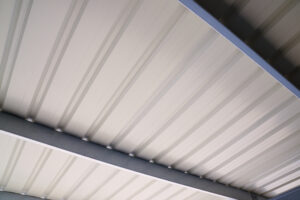
2️⃣ Single-Skin Steel with Anti-Condensation Liner
Overview:
An upgraded version of standard single-skin roofing, featuring a non-woven anti-condensation fleece applied to the underside of the sheet. It absorbs moisture and releases it gradually, reducing the risk of drips and dampness.
Best for:
- Semi-enclosed agricultural buildings
- Workshops, garages, or stores with moderate condensation risk
Advantages:
- Reduces condensation in uninsulated environments
- Retains simplicity and affordability
Considerations:
- Not a thermal insulation solution
- Performs best with good ventilation
3️⃣ Composite Insulated Roofing Panels
Overview:
Composite (or “sandwich”) panels combine outer and inner steel sheets with an insulated PIR or mineral wool core. They offer superior thermal and airtight performance, meeting Part L requirements for energy efficiency.
Insulation Thicknesses & Typical Applications:
| Panel Thickness | Typical U-Value (W/m²K) | Common Use |
|---|---|---|
| 40mm | 0.46 | Ambient or unheated stores |
| 60mm | 0.35 | Lightly heated workshops |
| 80mm | 0.26 | Insulated industrial units |
| 100mm | 0.2 | Offices or regularly heated workspaces |
| 120mm–150mm | 0.16–0.13 | High-spec or low-energy builds |
Best for:
- Heated industrial and commercial buildings
- Offices, workshops, and warehouses
- Fast-track construction projects
Advantages:
- Excellent thermal efficiency
- Quick installation (single-step fix)
- Neat, low-maintenance internal finish
Considerations:
- Higher upfront cost
- Less adaptable for complex roof shapes
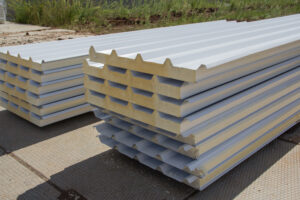
4️⃣ Twin-Skin / Built-Up Insulated Roofing Systems
Overview:
A site-assembled alternative to composite panels. Twin-skin systems use an outer weather sheet, inner liner sheet, and insulation layer (commonly mineral wool) installed between spacer bars.
This system offers excellent flexibility for bespoke insulation and acoustic performance, making it a popular choice for both new-builds and refurbishments.
Best for:
- Large-scale industrial or commercial buildings
- Workshops or plant areas with machinery noise
- Refurbishments requiring adaptable detailing
Advantages:
- Exceptional acoustic performance — mineral wool and double-skin layers absorb sound, reducing both airborne and impact noise. Ideal for noise-sensitive environments or buildings near residential areas.
- Customisable thermal performance — insulation thickness can be tailored to meet specific U-values or regulatory standards.
- Easy to maintain or upgrade — individual layers can be replaced.
- Strong fire resistance and long-term durability.
Considerations:
- Requires skilled installation for air-tightness and weatherproofing.
- Longer installation time than composite panels.
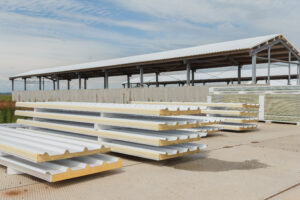
5️⃣ Fibre Cement Roofing
Overview:
Fibre cement remains a trusted, traditional material for agricultural buildings. It’s breathable, corrosion-resistant, and provides natural moisture regulation.
Best for:
- Livestock housing and equestrian buildings
- Agricultural stores needing quiet, well-ventilated environments
Advantages:
- Naturally reduces condensation
- Excellent acoustic dampening — quieter during rainfall
- Resistant to rust and chemical exposure
Considerations:
- Heavier than steel
- Unsuitable for fully insulated environments
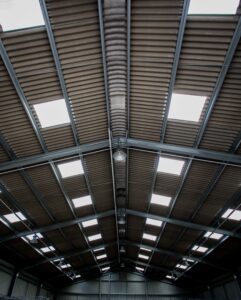
Which Roof Type Suits Your Building?
| Building Type | Recommended Roofing Type | Key Benefits |
|---|---|---|
| Machinery or hay store | 0.7mm single-skin steel | Simple, affordable, durable |
| General-purpose agricultural building | Steel with anti-condensation liner | Reduces moisture and drips |
| Insulated workshop or warehouse | Composite or twin-skin system | Energy-efficient and regulation-compliant |
| Office or heated workspace | Composite panels (80–120mm) | Comfortable, low running costs |
| Livestock building | Fibre cement | Breathable, quiet, condensation-resistant |
The ReviveLogix Perspective
At ReviveLogix, we believe every roof should balance performance, compliance, and practicality. Whether you’re designing a high-spec industrial workspace or a straightforward agricultural store, we’ll help you specify the most effective and efficient solution.
We focus on long-term results — ensuring your roof not only meets today’s standards but performs reliably for years to come.
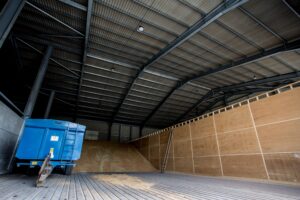
🔧 Need Expert Guidance?
Choosing the right roof isn’t just about picking materials — it’s about understanding how your building performs thermally, acoustically, and structurally.
At ReviveLogix, we guide you through every option, helping you select the best roofing system for your project, budget, and long-term requirements.
👉 Contact us today to discuss your next industrial or agricultural building project.
